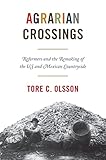Agrarian Crossings : Reformers and the Remaking of the US and Mexican Countryside / Tore C. Olsson.
Material type: TextSeries: America in the World ; 24Publisher: Princeton, NJ : Princeton University Press, [2017]Copyright date: ©2017Description: 1 online resource (296 p.) : 21 halftonesContent type:
TextSeries: America in the World ; 24Publisher: Princeton, NJ : Princeton University Press, [2017]Copyright date: ©2017Description: 1 online resource (296 p.) : 21 halftonesContent type: - 9780691165202
- 9781400888054
- Agriculture and state -- Mexico -- History -- 20th century
- Agriculture and state -- Southern States -- History -- 20th century
- Land reform -- Mexico -- History -- 20th century
- Land reform -- Southern States -- History -- 20th century
- Land use, Rural -- Mexico -- History -- 20th century
- Land use, Rural -- Southern States -- History -- 20th century
- HISTORY / Social History
- American
- Cold War
- Farm Security Administration
- Frank Tannenbaum
- General Education Board
- Josephus Daniels
- Latin American
- Mexican Agricultural Program
- Mexican Revolution
- Mexican agrarian reform
- Mexican countryside
- Mexico
- Miguel Alemán
- New Deal politics
- New Deal
- Rockefeller Foundation
- Southern Tenant Farmers' Union
- Tennessee Valley Authority
- US Populist movement
- US South
- United States
- agrarian justice
- agrarian policy
- agrarian radicalism
- agrarian reform
- agrarian revolts
- agrarian revolution
- agricultural productivity
- agricultural reform
- agriculture
- countryside
- ejido farmers
- environmental decline
- haciendas
- hydraulic development program
- inequality
- land reform
- land tenure
- landholding
- plantations
- rural poverty
- rural reform
- rural reformers
- rural social transformation
- rural transformation
- 333.760975 23
- HD207 .O47 2018
- online - DeGruyter
- Issued also in print.
| Item type | Current library | Call number | URL | Status | Notes | Barcode | |
|---|---|---|---|---|---|---|---|
 eBook
eBook
|
Biblioteca "Angelicum" Pont. Univ. S.Tommaso d'Aquino Nuvola online | online - DeGruyter (Browse shelf(Opens below)) | Online access | Not for loan (Accesso limitato) | Accesso per gli utenti autorizzati / Access for authorized users | (dgr)9781400888054 |
Frontmatter -- CONTENTS -- ILLUSTRATIONS -- ACKNOWLEDGMENTS -- INTRODUCTION -- Chapter One: Parallel Agrarian Societies -- Chapter Two: Sharecroppers and Campesinos -- Chapter Three: Haciendas and Plantations -- Chapter Four: Rockefeller Rural Development -- Chapter Five: Green Revolutions -- Chapter Six: Transplanting "El Tenesí" -- Epilogue -- Notes -- ARCHIVES AND MANUSCRIPT COLLECTIONS CONSULTED -- INDEX
restricted access online access with authorization star
http://purl.org/coar/access_right/c_16ec
In the 1930s and 1940s, rural reformers in the United States and Mexico waged unprecedented campaigns to remake their countrysides in the name of agrarian justice and agricultural productivity. Agrarian Crossings tells the story of how these campaigns were conducted in dialogue with one another as reformers in each nation came to exchange models, plans, and strategies with their equivalents across the border.Dismantling the artificial boundaries that can divide American and Latin American history, Tore Olsson shows how the agrarian histories of both regions share far more than we realize. He traces the connections between the US South and the plantation zones of Mexico, places that suffered parallel problems of environmental decline, rural poverty, and gross inequities in land tenure. Bringing this tumultuous era vividly to life, he describes how Roosevelt's New Deal drew on Mexican revolutionary agrarianism to shape its program for the rural South. Olsson also looks at how the US South served as the domestic laboratory for the Rockefeller Foundation's "green revolution" in Mexico-which would become the most important Third World development campaign of the twentieth century-and how the Mexican government attempted to replicate the hydraulic development of the Tennessee Valley Authority after World War II.Rather than a comparative history, Agrarian Crossings is an innovative history of comparisons and the ways they affected policy, moved people, and reshaped the landscape.
Issued also in print.
Mode of access: Internet via World Wide Web.
In English.
Description based on online resource; title from PDF title page (publisher's Web site, viewed 29. Jul 2021)


